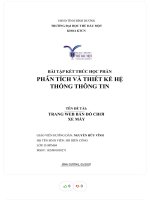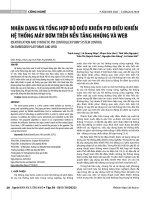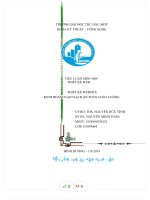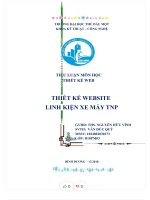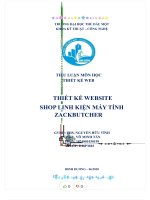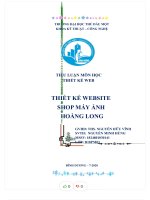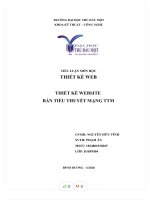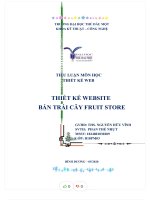a0057 apress pro javascript for web apps jun 201 morebook vn 5315
Bạn đang xem bản rút gọn của tài liệu. Xem và tải ngay bản đầy đủ của tài liệu tại đây (1009.3 KB, 7 trang )
Download from Wow! eBook <www.wowebook.com>
For your convenience Apress has placed some of the front
matter material after the index. Please use the Bookmarks
and Contents at a Glance links to access them.
Contents at a Glance
About the Author................................................................................................... xii
About the Technical Reviewer ............................................................................. xiii
Acknowledgments ............................................................................................... xiv
Chapter 1: Getting Ready ........................................................................................1
Chapter 2: Getting Started ....................................................................................15
Chapter 3: Adding a View Model...........................................................................47
Chapter 4: Using URL Routing ...............................................................................77
Chapter 5: Creating Offline Web Apps.................................................................109
Chapter 6: Storing Data in the Browser ..............................................................137
Chapter 7: Creating Responsive Web Apps.........................................................169
Chapter 8: Creating Mobile Web Apps ................................................................195
Chapter 9: Writing Better JavaScript..................................................................229
Index ...................................................................................................................261
iv
CHAPTER 1
Getting Ready
Client-side web app development has always been the poor cousin to server-side coding. This started
because browsers and the devices they run on have been less capable than enterprise-class servers. To
provide any kind of serious web app functionality, the server had to do all of the heavy lifting for the
browsers, which was pretty dumb and simple by comparison.
Over the last few years, browsers have got smarter, more capable, and more consistent in how they
implement web technology and standards. What used to be a fight to create unique features has become
a battle to create the fastest and most compliant browser. The proliferation of smartphones and tablets
has created a huge market for high-quality web apps, and the gradual adoption of HTML5 provides web
application developers with a solid foundation for building rich and fluid client-side experiences.
Sadly, while the client-side technology has caught up with the server side, the techniques that
client-side programmers use still lag behind. The complexity of client-side web apps has reached a
tipping point where scale, elegance, and maintainability are essential and the days of hacking out a
quick solution have passed. In this book, I level the playing field, showing you how to step up your
client-side development to embrace the best techniques from the server-side world and combine them
with the latest HTML5 features.
About This Book
This is my 15th book about technology, and to mark this, Apress asked me to do something different:
share the tools, tricks, and techniques that I use to create complex client-side web apps. The result is
something that is more personal, informal, and eclectic than my regular work. I show you how to take
industrial-strength development concepts from server-side development and apply them to the
browser. By using these techniques, you can build web apps that are easier to write, are easier to
maintain, and offer better and richer functionality to your users.
Who Are You?
You are an experienced web developer whose projects have started to get out of control. The number of
bugs in your JavaScript code is increasing, and it takes longer to find and fix each one. You are targeting
an ever-wider range of device, including desktops, tablets, and smartphones, and keeping it all working
is getting tougher. Your working days are longer, but you have less time to spend on new features
because maintaining the code you already have sucks up a big chuck of your time.
The excitement that comes from your work has faded, and you have forgotten what it feels like to
have a really productive day of coding. You know something is wrong, you know that you are losing your
grip, and you know you need to find a different approach. If this sounds familiar, then you are my target
reader.
1
CHAPTER 1 GETTING READY
What Do You Need to Know Before You Read This Book?
This is an advanced book, and you need to be an experienced web programmer to understand the
content. You need a working knowledge of HTML, you need to know how to write JavaScript, and you
have used both to create client-side web apps. You will need to understand how a browser works, how
HTTP fits into the picture, and what Ajax requests are and why you should care about them.
What If You Don’t Have That Experience?
You may still get some benefit from this book, but you will have to figure out some of the basics on your
own. I have written a couple of other books you might find useful as primers for this one. If you are new
to HTML, then read The Definitive Guide to HTML5. This explains everything you need to create regular
web content and basic web apps. I explain how to use HTML markup and CSS3 (including the new
HTML5 elements) and how to use the DOM API and the HTML5 APIs (including a JavaScript primer if
you are new to the language). I make a lot of use of jQuery in this book. I provide all of the information
you need for each topic, but if you want a better grounding in how jQuery works and how it relates to the
DOM API, then read Pro jQuery. Both of these books are published by Apress.
Books aside, you can learn a lot about HTML and the browser APIs by reading the specifications
published by the W3C at www.w3.org. The specifications are authoritative but can be hard-going and are
not always that clear. A more readily accessible resource is the Mozilla Developer Network at
. This is an excellent source of information about everything from HTML
to JavaScript. There is a general bias toward Firefox, but this isn’t usually a problem since the
mainstream browsers are generally compliant and consistent in the way they implement web standards.
Is This a Book About HTML5?
No, although I do talk about some of the new HTML5 JavaScript APIs. Most of this book is about
technique, most of which will work with HTML4 just as it does with HTML5. Some chapters are built
purely on HTML5 APIs (such as Chapters 5 and 6, which show you how to create web apps that work
offline and how to store data in the browser), but the other chapters are not tied to any particular version
of HTML. I don’t get into any detail about the new elements described in HTML5. This is a book about
programming, and the new elements don’t have much impact on JavaScript programming.
What Is the Structure of This Book?
In Chapter 2, I build a simple web app for a fictitious cheese retailer called CheeseLux, building on the
basic example I introduce later in this chapter. I follow some pretty standard approaches for creating
this web app and spend the rest of the book showing you how to apply industrial-strength techniques to
improve different aspects. I have tried to keep each chapter reasonably separate, but this is a reasonably
informal book, and I do introduce some concepts gradually over a number of chapters. Each chapter
builds on the techniques introduced in the chapters that go before it. You should read the book in
chapter order if you can. The following sections summarize the chapters in this book.
Chapter 1: Getting Ready
Aside from describing this book, I introduce the static HTML version of the CheeseLux example, which I
use throughout this book. I also list the software you will need if you want to re-create the examples on
your own or experiment with the listings that are included in the source code download that
accompanies this book (and which is available free from Apress.com).
2
About the Technical Reviewer
RJ Owen is the lead experience planner at EffectiveUI, focusing on
customer insight work, including ethnographic research, design validation,
co-creation exercises, and expert design. RJ started his career as a software
developer and spent ten years working in C++, Java, and Flex before moving
to the design research and customer insight team at EffectiveUI. He truly
loves good design and understanding what makes people tick. RJ holds an
MBA and a bachelor’s in physics and computer science. He is a frequent
speaker at many industry events, including Web 2.0, SXSW, and Adobe
MAX.
xiii
Acknowledgments
I would like to thank everyone at Apress for working so hard to bring this book to print. In particular,
I would like to thank Jennifer Blackwell for keeping me on track and Ben Renow-Clarke for
commissioning and editing this title. I would also like to thank my technical reviewer, RJ Owen,
whose efforts made this book far better than it would have been otherwise.
xiv
